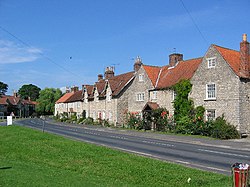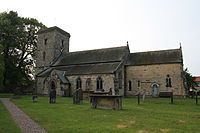Hovingham
| Hovingham | |
| Yorkshire North Riding | |
|---|---|
 Hovingham | |
| Location | |
| Grid reference: | SE667528 |
| Location: | 54°10’18"N, 0°58’44"W |
| Data | |
| Population: | 362 (2011) |
| Post town: | York |
| Postcode: | YO62 |
| Local Government | |
| Council: | North Yorkshire |
| Parliamentary constituency: |
Thirsk and Malton |
Hovingham is a large village in the North Riding of Yorkshire. It is on the edge of the Howardian Hills and about seven miles south of Kirkbymoorside.
Contents
History
The name 'Hovingham' is first attested in the Domesday Book of 1086, where it appears as Hovingham. The settlement lay within the Maneshou hundred. The lands at the time of the Norman invasion belonged to Orm, son of Gamal. After the invasion, the lands were granted to Hugh, son of Baldric.[1] The name 'Hovingham' means 'the village of Hofa's people'.[2]
There is evidence of Roman activity around the village which sat on the Malton to Aldburgh road in those times. During the construction of Hovingham Hall gardens, a Roman bath, tesselated pavement and other artefacts were uncovered.[3]
The village had a station on the Thirsk and Malton branch of the North Eastern Railway.[3][4]
The 1881 UK Census recorded the population as 600.[3] The 2011 Census recorded a population of 362.
Churches
- Church of England: All Saints
- Methodist
The Church of All Saints is a Grade II listed building[5] The majority of the present church building dates back to 1860, when it was rebuilt at the expense of Marcus Worsley. The tower is of Anglo-Saxon origin.[3] An interesting feature is the large 10th-century altar cross.[6]
About the village
The nearest settlements are Slingsby two miles to the east; Stonegrave a mile and a hald to the north; Cawton two miles to the north-west; Coulton two miles west and Scackleton two miles south-west. Marrs Beck flows northwards through the village to eventually join the River Rye near Butterwick and Brawby.
Limestone is quarried in Wath about half a mile east of Hovingham.
Hovingham Hall
- Main article: Hovingham Hall
Hovingham has been home to the Worsley family since 1563[7] and was the childhood home of the Duchess of Kent.[8] The sixth Thomas Worsley (1710–1778) designed and built the current Hovingham Hall. It is a Grade I listed building. A unique feature of the hosue is that it is entered through a covered Riding School, once used for training horses.
Sport
- Cricket: Hovingham Cricket Club[9]
- Tennis
Music
The Hovingham Festival was founded by local clergyman Canon Thomas Percy Hudson in 1887.[10] He persuaded the Worsley family to make their eighteenth-century riding school at Hovingham Hall available for a rural Yorkshire music festival that included leading professional musicians - including Joseph Joachim - supplementing the choirs and orchestras with local amateurs to make the cost of putting on ambitious works affordable.[11] The repertoire was ambitious, including works (alongside the classics) by contemporary British composers - Elgar, Alan Gray, Parry, Somervell, Stanford and William Sterndale Bennett, and choral works by women composers such as Laura Wilson Barker (also known as Mrs Tom Taylor) and Alexandra Thomson.[12] Thirteen festivals were held until 1906.[13] The event was revived after 45 years during the 1950s.[14]
Pictures
| ("Wikimedia Commons" has material about Hovingham) |
References
- ↑ Hovingham in the Domesday Book
- ↑ Ekwall, Eilert, The Concise Oxford Dictionary of English Place-Names. Oxford, Oxford University Press, 4th edition, 1960. p. 253 ISBN 0198691033
- ↑ 3.0 3.1 3.2 3.3 Bulmer's Topography, History and Directory (Private and Commercial) of North Yorkshire 1890. S&N Publishing. 1890. p. 714. ISBN 1-86150-299-0.
- ↑ Butt, R. V. J. (1995). The Directory of Railway Stations: details every public and private passenger station, halt, platform and stopping place, past and present (1st ed.). Sparkford: Patrick Stephens Ltd. ISBN 978-1-85260-508-7. OCLC 60251199.
- ↑ National Heritage List : Church of All Saints (Grade II listing)@"Church Listing". http://www.britishlistedbuildings.co.uk/en-329055-church-of-all-saints-hovingham-north-yor. Retrieved 27 December 2012.
- ↑ "Hovingham ◊ The Street Parishes". thestreetparishes.org.uk. http://thestreetparishes.org.uk/hovingham.html. Retrieved 28 June 2009.
- ↑ "Hovingham Hall – House and Gardens". hovingham.co.uk. http://www.hovingham.co.uk/home.html. Retrieved 28 June 2009.
- ↑ "The Duchess of Kent – living life in the shadows". Royal Central. http://royalcentral.co.uk/blogs/the-duchess-of-kent-living-life-in-the-shadows-43878.
- ↑ "Cricket Club". http://www.yorkercricket.co.uk/Clubs/Hovingham/Directory.html. Retrieved 27 December 2012.
- ↑ Thomas Percy Hudson, biography by Trinity College Chapel
- ↑ Antony Pemberton. A Trip Round My Dining Room Walls (2011)
- ↑ Arrandale, Karen. Edward J. Dent: A Life of Words and Music (2023), p. 11
- ↑ Drummond, Pippa.The Provincial Music Festival in England, 1784-1914 (2016), p. 159-60
- ↑ 'The Fourteenth Hovingham Festival', in The Musical Times Vol. 92, No. 1303 (September 1951), p. 417





